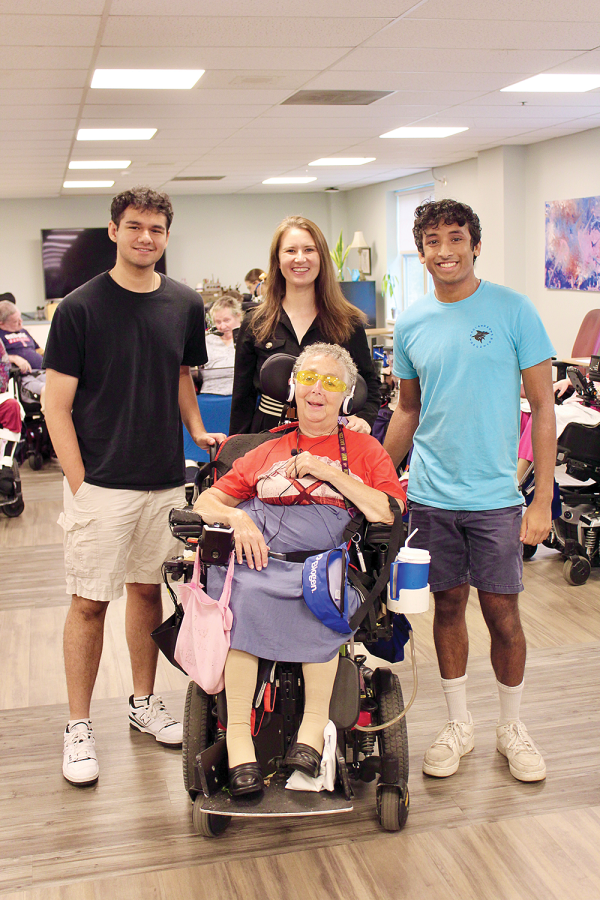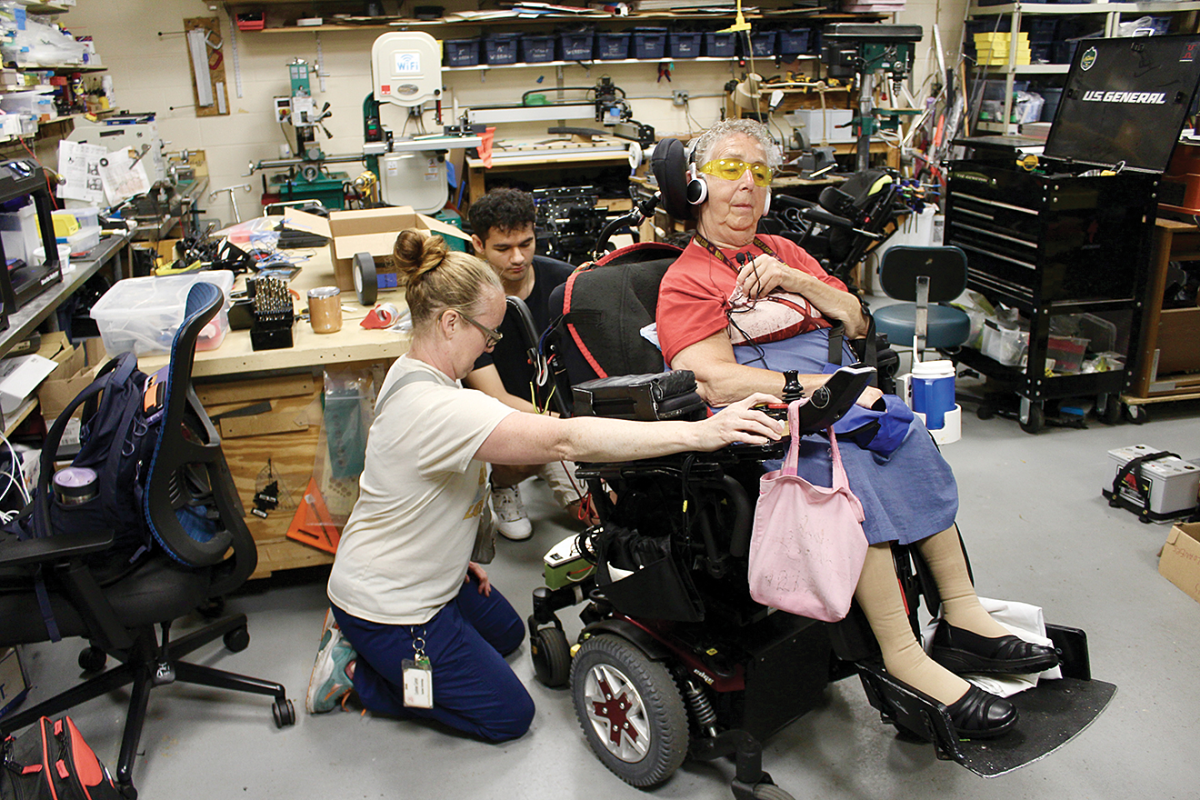June 13, 2024

Alexander Pervizi, left, Kristina Johnson, middle, and Hari Narayanam, right, proudly gather around Sarah after she showed the HULA to the home’s residents.
One of the residents at The Boston Home (TBH) on Dorchester Avenue at Gallivan Blvd. has been equipped with a low-cost device to help her navigate her way through her day, thanks to a team of engineers-in-training at Northeastern University (NU).
The Reporter was on hand as four students visited the TBH campus last month to test the equipment they had created for Sarah, a resident who has Multiple Sclerosis (MS). Most electric wheelchairs – like the ones Sarah and many other TBH residents use – rely on sounds and lights to help their users move around. But this is not an effective mode of communication for people like Sarah, who is also visually and hearing impaired.
Kristina Johnson, an associate professor at NU, helped the students – Charles Caiola, Darsh Jha, Hari Narayanam, and Alexander Pervizi – develop a solution as part of NU’s Enabling Engineering class.

Corrine Curran helped Sarah test out the HULA in one of The Boston Home elevators. When Sarah got close to the wall, the sensors vibrated the arm sleeves, reminding her that something was behind her. Cassidy McNeeley photos
“These projects are done from start to finish in 13 weeks,” Johnson explained. “From the first day of class to the last day of class, that’s all the time they have to build this, trial it, implement it, and deliver it.”
The invention the group came up with is called a Haptic Ultrasonic Location Assistant (HULA). It includes a bar with ultrasonic sensors each of which has a 180-degree radius set to detect objects within 8, 10, and 12 inches of it. That triggers a buzzing sensation that lets Sarah know that there is an obstacle behind her.
“She needs touch, something that’s tactile,” Johnson told the Reporter. “The students worked through this on their own and they came up with the haptic sensor, which is like the vibrations in your phone, and tested a lot of different design iterations for how to embed the haptic sensors in the chair.”
The students visited the Home numerous times throughout the semester to collaborate with Sarah and the Home’s assistive technology coordinator, Corrine Curran. There is a commercially available product that could help, too, said Curran, but they can cost over $10,000.
“It was very expensive, and insurance wouldn’t cover it because the person lived in a facility,” said Curran. “It was horrible, it just did not work in a facility, but it’s such a needed piece of equipment that when we got hooked up with the Northeastern students this was the first thing we thought of.”
Alexander Pervizi, one of the students, helped to install the device. “We had a whole semester to work on this project and we made a promise to Sarah that the least we can do is deliver the product in its final state,” said Pervizi, a third-year student majoring in electrical engineering and physics. “It’s a rewarding experience to go from having nothing to a final creation that helps somebody and will hopefully be used for a long time.”
The finished product cost just $87, according to Priyanka Jalan, the program manager at Enabling Engineers. “The sensor project is a very successful project for what the Enabling Engineers mission stands for, which is to really make products more accessible to our community in terms of price,” said Jalan. The program was founded by Northeastern associate professor and graduate education vice provost Waleed Meleis in 2010.
Now that she’s equipped with the HULA, Sarah can move around without limiting her independence. It has been a big help on her beloved morning trips to the TBH garden.
“We have seen firsthand how quickly people decline when you take their driving away from them,” said Curran. “Sarah will know if she gets too close to something but it’s not going to stop her chair or prohibit her from doing anything or going anywhere she wants to go. If she can get within eight inches of the wall and be safe, it’s fine. All it’s going to do is give her the vibration on her arm pads to know that she’s getting close to something.”
While setting Sarah up with the HULA, Pervizi and Narayanam showed their affordable product to other home residents. “We had hopes but we didn’t have the expectation it would be done so well, but it worked flawlessly,” said Narayanam, who is also a third-year majoring in electrical engineering. “Seeing everyone’s faces saying they could use it was very rewarding,”
He added: “I think the most important thing is each of these wheelchairs is very different, so you have to make the sensor adaptable to each one. Making a sensor that could encompass all of them would be great. Going about that, I don’t know yet.”
“The goal for next semester is to do it for several residents,” said Johnson. “Scale it up or get it streamlined in such a way that Corrine could build it in an afternoon and really implement it. Expanding the solution to include other sensors and making it more adaptable to other wheelchairs is the biggest gain, and then design changes like making the wires better, armrests fancier, improving the connecting point, the customizability, and all those things.”
She added: “The Boston Home is so dedicated to the residents who live here, it is clearly a family, and we are really lucky to be a part of that.”


